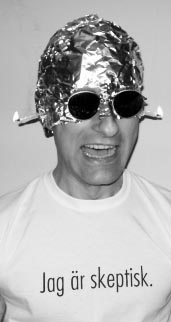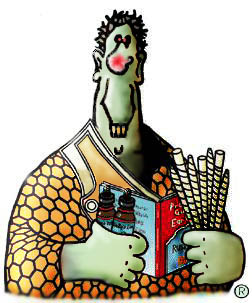|
 A
fine
example of pseudoscience is "ear candling," a current practice popular with
customers of organic grocery and health food stores where. the candles are sold.
Manufacturers of these products claim or strongly imply that car candling will facilitate
the removal of wax or cerumen from the ear.
A
fine
example of pseudoscience is "ear candling," a current practice popular with
customers of organic grocery and health food stores where. the candles are sold.
Manufacturers of these products claim or strongly imply that car candling will facilitate
the removal of wax or cerumen from the ear.
For example, the 'Wallys Candles A Home
Remedy' brochure that accompanies a package of two ear candles (which costs approximately
seven dollars) states that these candles, "have been reported to aid in cleansing the
ear, improve hearing and bring soothing comfort to the user." The brochure continues
with a list of statements concerning how ear wax build-up can lead to "hearing loss,
infections, ringing-of-the-ears, headaches, congestion and loss of balance."
The candle, which is more accurately described
as a cone or funnel since it is hollow, consists of beeswax and cotton cloth. The process
of ear candling begins by placing the narrow end of the tapered candle just inside the ear
as the person lies flat on one side of their body. The top of the candle is then ignited
and once half the candle burns, it is removed and extinguished; an aluminum pie pan is
usually used to collect any burning debris. The burning of the candle supposedly creates a
negative pressure inside the ear, drawing ear wax up and out of the ear. When the candle
is cut open (this is not part of the manufacturer's instructions), a fairly large deposit
of a dried yellow solid is found inside. This substance is easily mistaken as wax from the
person's ear, but in reality it is the beeswax from the candle itself. The beeswax is
extracted into the inside space of the candle by a pressure differential. As the oxygen
inside the candle is consumed during combustion, the atmospheric pressure inside the
candle decreases. This allows some of the wax to travel from the candle itself into the
empty space inside the candle. When the candle is cut open, the wax observed is in the
form of a dried powder since moisture is evaporated during the burning process.
Two simple tests can be performed to show that
no earwax is indeed removed by the candling procedure. First, acquire a small clean test
tube (to simulate the narrow ear canal) and into it add a weighed piece of wax, preferably
human earwax. Heat the test tube containing the wax to body temperature in a hot water
bath. Next, fit the candle into the test tube and then ignite the top of the candle with a
match. After about half the candle has burned, extinguish the flame. When one examines the
test tube containing the human earwax during the burning process, it will be observed that
the earwax does not change in any way; it neither travels up the test tube nor does it
enter the candle. The mass of the human earwax before and after candling is the same.
Furthermore, when one opens up the bottom tip of the partially burned candle, the dried
solid is observed to be in a quantity greater than the earwax placed in the test tube.
This simulation strongly suggests that none of the human earwax is being removed by the
candling process, but instead, the extracted substance originates from the candle itself
 A second test supports these findings. When the
above procedure is repeated but without any human earwax in the test tube, the same result
occurs -- a yellow dried solid is found inside the bottom tip of the candle. A second test supports these findings. When the
above procedure is repeated but without any human earwax in the test tube, the same result
occurs -- a yellow dried solid is found inside the bottom tip of the candle.
The results of these tests are further supported by a recent medical study evaluating the
efficacy and safety of ear candling (Seely et al. 1996). In a limited clinical trial
(eight patients), it was found using tympanometric measurements that ear candles did not
produce a negative pressure inside the ear nor did the candles remove cerumen from the car
as claimed. Furthermore, in a survey of 122 otolaryngologists, twenty-one ear injuries
were identified resulting from using ear candles. In the definitive words of the authors,
"Ear candles have no benefit in the management of cerumen and may result in serious
injury."
-Stephen DeMeo
Stephen DeMeo is in the Department of Chemistry, City University
of New York at York College in Jamaica, AT 11451. |
 A
fine
example of pseudoscience is "ear candling," a current practice popular with
customers of organic grocery and health food stores where. the candles are sold.
Manufacturers of these products claim or strongly imply that car candling will facilitate
the removal of wax or cerumen from the ear.
A
fine
example of pseudoscience is "ear candling," a current practice popular with
customers of organic grocery and health food stores where. the candles are sold.
Manufacturers of these products claim or strongly imply that car candling will facilitate
the removal of wax or cerumen from the ear. A second test supports these findings. When the
above procedure is repeated but without any human earwax in the test tube, the same result
occurs -- a yellow dried solid is found inside the bottom tip of the candle.
A second test supports these findings. When the
above procedure is repeated but without any human earwax in the test tube, the same result
occurs -- a yellow dried solid is found inside the bottom tip of the candle.